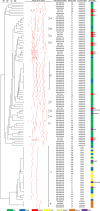Determination of genotypic diversity of Mycobacterium avium subspecies from human and animal origins by mycobacterial interspersed repetitive-unit-variable-number tandem-repeat and IS1311 restriction fragment length polymorphism typing methods
- PMID: 20107094
- PMCID: PMC2849548
- DOI: 10.1128/JCM.01869-09
Determination of genotypic diversity of Mycobacterium avium subspecies from human and animal origins by mycobacterial interspersed repetitive-unit-variable-number tandem-repeat and IS1311 restriction fragment length polymorphism typing methods
Abstract
Members of the Mycobacterium avium complex (MAC) are ubiquitous bacteria that can be found in water, food, and other environmental samples and are considered opportunistic pathogens for numerous animal species, mainly birds and pigs, as well as for humans. We have recently demonstrated the usefulness of a PCR-based mycobacterial interspersed repetitive-unit-variable-number tandem-repeat (MIRU-VNTR) typing for the molecular characterization of M. avium subsp. paratuberculosis and M. avium strains exclusively isolated from AIDS patients. In the present study we extended our analysis, based on eight MIRU-VNTR markers, to a strain collection comprehensively comprising the other M. avium subspecies, including M. avium subsp. avium, M. avium subsp. hominissuis, and M. avium subsp. silvaticum, isolated from numerous animal species, HIV-positive and HIV-negative humans, and environmental sources. All strains were fully typeable, with the discriminatory index being 0.885, which is almost equal to that obtained by IS1311 restriction fragment length polymorphism (RFLP) typing as a reference. In contrast to IS1311 RFLP typing, MIRU-VNTR typing was able to further discriminate M. avium subsp. avium strains. MIRU-VNTR alleles strongly associated with or specific for M. avium subspecies were detected in several markers. Moreover, the MIRU-VNTR typing-based results were consistent with a scenario of the independent evolution of M. avium subsp. avium/M. avium subsp. silvaticum and M. avium subsp. paratuberculosis from M. avium subsp. hominissuis, previously proposed on the basis of multilocus sequence analysis. MIRU-VNTR typing therefore appears to be a convenient typing method capable of distinguishing the three main subspecies and strains of the complex and providing new epidemiological knowledge on MAC.
Figures


Similar articles
-
[Genetic research about Mycobacterium avium complex].Kekkaku. 2011 Feb;86(2):61-8. Kekkaku. 2011. PMID: 21404652 Japanese.
-
Comparison of a variable-number tandem-repeat (VNTR) method for typing Mycobacterium avium with mycobacterial interspersed repetitive-unit-VNTR and IS1245 restriction fragment length polymorphism typing.J Clin Microbiol. 2009 Jul;47(7):2156-64. doi: 10.1128/JCM.02373-08. Epub 2009 Apr 29. J Clin Microbiol. 2009. PMID: 19403768 Free PMC article.
-
New variable-number tandem-repeat markers for typing Mycobacterium avium subsp. paratuberculosis and M. avium strains: comparison with IS900 and IS1245 restriction fragment length polymorphism typing.J Clin Microbiol. 2007 Aug;45(8):2404-10. doi: 10.1128/JCM.00476-07. Epub 2007 May 30. J Clin Microbiol. 2007. PMID: 17537942 Free PMC article.
-
[Mycobacterium avium-intracellulare complex: phenotypic and genotypic markers and the molecular basis for interspecies transmission].Bull Soc Pathol Exot. 2000 Jul;93(3):182-92. Bull Soc Pathol Exot. 2000. PMID: 11030055 Review. French.
-
[New era in molecular epidemiology of tuberculosis in Japan].Kekkaku. 2006 Nov;81(11):693-707. Kekkaku. 2006. PMID: 17154049 Review. Japanese.
Cited by
-
Genotyping of swine Mycobacterium avium subsp. hominissuis isolates from Kyushu, Japan.J Vet Med Sci. 2019 Aug 9;81(8):1074-1079. doi: 10.1292/jvms.19-0048. Epub 2019 Jun 3. J Vet Med Sci. 2019. PMID: 31155550 Free PMC article.
-
Comparative genomics of Mycobacterium avium subsp. hominissuis strains within a group of captive lowland tapirs.PLoS One. 2025 Apr 1;20(4):e0320499. doi: 10.1371/journal.pone.0320499. eCollection 2025. PLoS One. 2025. PMID: 40168336 Free PMC article.
-
Housekeeping gene sequencing and multilocus variable-number tandem-repeat analysis to identify subpopulations within Pseudomonas syringae pv. maculicola and Pseudomonas syringae pv. tomato that correlate with host specificity.Appl Environ Microbiol. 2012 May;78(9):3266-79. doi: 10.1128/AEM.06655-11. Epub 2012 Mar 2. Appl Environ Microbiol. 2012. PMID: 22389364 Free PMC article.
-
Molecular typing of Argentinian Mycobacterium avium subsp. paratuberculosis isolates by multiple-locus variable number-tandem repeat analysis.Braz J Microbiol. 2015 Jun 1;46(2):557-64. doi: 10.1590/S1517-838246220140283. eCollection 2015 Jun. Braz J Microbiol. 2015. PMID: 26273274 Free PMC article.
-
Population Structure and Local Adaptation of MAC Lung Disease Agent Mycobacterium avium subsp. hominissuis.Genome Biol Evol. 2017 Sep 1;9(9):2403-2417. doi: 10.1093/gbe/evx183. Genome Biol Evol. 2017. PMID: 28957464 Free PMC article.
References
-
- Biet, F., M. L. Boschiroli, M. F. Thorel, and L. A. Guilloteau. 2005. Zoonotic aspects of Mycobacterium bovis and Mycobacterium avium-intracellulare complex (MAC). Vet. Res. 36:411-436. - PubMed
-
- Bull, T. J., K. Sidi-Boumedine, E. J. McMinn, K. Stevenson, R. Pickup, and J. Hermon-Taylor. 2003. Mycobacterial interspersed repetitive units (MIRU) differentiate Mycobacterium avium subspecies paratuberculosis from other species of the Mycobacterium avium complex. Mol. Cell. Probes 17:157-164. - PubMed
Publication types
MeSH terms
Substances
LinkOut - more resources
Full Text Sources

